|
Battle Of Franklin (other)
The Battle of Franklin was a major battle of the American Civil War. It was fought at Franklin, Tennessee, on November 30, 1864, as part of the Franklin–Nashville Campaign. Battle of Franklin may also refer to: American Civil War * Battle of Franklin (1863), a minor engagement on April 10, 1863, in Williamson County, Tennessee * Joint Expedition Against Franklin, fought October 3, 1862, in Franklin, Virginia, and the nearby Blackwater River * Battle of Irish Bend, fought April 14, 1863, near Franklin, Louisiana Other uses * Battle of Franklin (1788), a skirmish between the governments of North Carolina and the unrecognized State of Franklin See also * Battle of Franklin's Crossing, a skirmish during the Gettysburg campaign {{disambig ... [...More Info...] [...Related Items...] OR: [Wikipedia] [Google] [Baidu] |
Battle Of Franklin
The Battle of Franklin was fought on November 30, 1864, in Franklin, Tennessee, as part of the Franklin–Nashville Campaign of the American Civil War. It was one of the worst disasters of the war for the Confederate States Army. Confederate Lieutenant General (CSA), Lieutenant General John Bell Hood's Army of Tennessee conducted numerous frontal assaults against fortified positions occupied by the Union Army, Union forces under Major General (United States), Major General John Schofield and was unable to prevent Schofield from executing a planned, orderly withdrawal to Nashville, Tennessee, Nashville. The Confederate assault of six infantry divisions containing eighteen brigades with 100 regiments numbering almost 20,000 men, sometimes called the "Pickett's Charge of the West", resulted in devastating losses to the men and the leadership of the Army of Tennessee—fourteen Confederate generals (six killed, seven wounded, and one captured) and 55 regimental commanders were casu ... [...More Info...] [...Related Items...] OR: [Wikipedia] [Google] [Baidu] |
Battle Of Franklin (1863)
The First Battle of Franklin, though technically not a battle, was fought April 10, 1863, in Williamson County, Tennessee, during the American Civil War. It was a minor engagement in about the same location as that of the more famous Battle of Franklin (November 30, 1864), which was part of the Franklin-Nashville Campaign. Battle The 1863 engagement at Franklin was a reconnaissance in force by Confederate cavalry Historically, cavalry (from the French word ''cavalerie'', itself derived from ''cheval'' meaning "horse") are groups of soldiers or warriors who Horses in warfare, fight mounted on horseback. Until the 20th century, cavalry were the most mob ... leader Major General (CSA), Maj. Gen. Earl Van Dorn, coupled with an inept response by Union Army, Union Major general (United States), Maj. Gen. Gordon Granger. Van Dorn advanced northward from Spring Hill, Tennessee, on April 10, making contact with Federal skirmishers just outside Franklin. Van Dorn's attack was so ... [...More Info...] [...Related Items...] OR: [Wikipedia] [Google] [Baidu] |
Joint Expedition Against Franklin
The Joint Expedition Against Franklin was a joint engagement between the Union army, United States Army and Union Navy, Navy against the Confederate States Army during the American Civil War. The engagement was intended to move Union forces into an area where Confederate forces were gathering as they prepared to move on Suffolk, Virginia. Originally planned as a coordinated two-pronged attack with a naval flotilla supporting an infantry advance on Franklin, Virginia, communications delays caused the Navy to start the mission before the Army was ready to support it. Instead, found Union Naval forces on the Blackwater River (Virginia), Blackwater River greatly outnumbered by Confederate infantrymen and ultimately forced to retreat. The naval action alone is also known as the Action at Crumpler's Bluff or the Battle of Crumpler's Bluff. Simultaneously, a nearby Army reconnaissance team conducted a failed assault on the town on the basis that the audibly nearby Naval forces&mda ... [...More Info...] [...Related Items...] OR: [Wikipedia] [Google] [Baidu] |
Battle Of Irish Bend
The Battle of Irish Bend, also known as Nerson's Woods or Franklin, took place during the American Civil War. It was fought between Union Major General Nathaniel Prentice Banks against Confederate Major General Richard Taylor during Banks's operations against the Bayou Teche region near Franklin, the seat of St. Mary Parish in southern Louisiana. Prelude While the other two Union XIX Corps divisions under Nathaniel Prentice Banks were comprising the expedition into west Louisiana crossed Berwick Bay towards Fort Bisland, Brigadier General Cuvier Grover’s division went up the Atchafalaya River into Grand Lake, where they could either block a Confederate retreat, or force a retreat if the Confederates stayed and fought at Fort Bisland. The battle occurred two days after the Battle of Fort Bisland. Battle On the morning of April 13, 1863, Grover's division landed in the vicinity of Franklin and scattered Confederate troops attempting to stop them from disembarking ... [...More Info...] [...Related Items...] OR: [Wikipedia] [Google] [Baidu] |
Battle Of Franklin (1788)
The State of Franklin (also the Free Republic of Franklin, Lost State of Franklin, or the State of Frankland) was an unrecognized proposed state located in present-day East Tennessee, in the United States. Franklin was created in 1784 from part of the territory west of the Appalachian Mountains that had been offered by North Carolina as a cession to Congress to help pay off debts related to the American War for Independence. It was founded with the intent of becoming the 14th state of the new United States. Franklin's first capital was Jonesborough. After the summer of 1787, the government of Franklin (which was by then based in Greeneville) ruled as a "parallel government" running alongside (but not harmoniously with) a re-established North Carolina bureaucracy. Franklin was never admitted into the union. The ''extra-legal'' state existed for only about four and a half years, ostensibly as a republic, after which North Carolina reassumed full control of the area. The creat ... [...More Info...] [...Related Items...] OR: [Wikipedia] [Google] [Baidu] |



